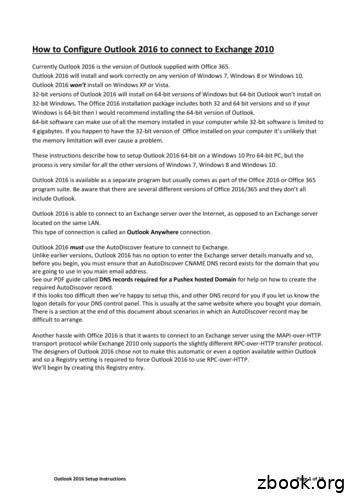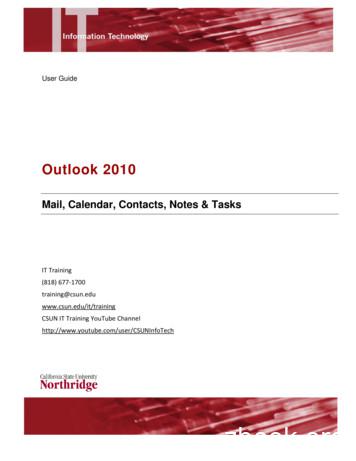Long-Term Energy Outlook - METI
Document 2Long-Term Energy OutlookTrends, Challenges, and Opportunities in a Rapidly Evolving SystemAdam SieminskiSeptember 29th, 20171
Key Takeaways The Global Energy SystemBehavioral EconomicsNo major near-term transformation likelyowing to the momentum advantage ofexisting energy networksUncertainty in consumer behavior is a keycomponent of deployment in renewablesand mobility developmentsCost Structure UncertaintiesThe Climate ChallengeForecasts for renewable energy have beenhampered by rapid improvements intechnology and materialsEmission reduction targets agreed atParis are not sufficient to meet the450ppm goalSource: CSIS2
Economic activity and population growth drive energy demandrelative fuel cost, government policies, and behavior set mixGDP and population growth drive energyGlobal GDP rising 3.7% 2015-2030; population up 1.1 billion (90% in non-OECD)Efficiency & consumer behaviorImproving efficiency & shifts in consumer behaviors reducing the energy intensity ofthe world economyElectricity demandFastest-growing form of end-use energy consumption, rising 1.5% per yearPolicy can shape fuel mixEfforts to diversify fuel mix favor non-fossil penetration in most key markets? Disruptive technology could upset the consensusReference case projections are not meant to be forecastsSource: CSIS3
Although population and per capita output continue to rise, energy andcarbon intensity are projected to continue to fall in the EIA Reference CasePopulationPer capita grossdomestic productMillion peopleEnergy intensityCarbon intensityThousand Btu per dollarMetric tons CO2 per billion BtuThousand 00101204001990201502040 19902015Source: EIA, International Energy Outlook 2017204001990201520404
World primary energy consumption: non-OECD growth dominatesQuadrillion BtuNon-OECDMiddle EastAfricaAmericasEuropeand 30Source: EIA, International Energy Outlook 2017204020505
World energy consumption: Coal not growing and could fall faster;renewables growing the fastest; electricity is the largest energy userWorld energy consumption by fuel sourceWorld energy consumption by fuel (with electricity separated)Quadrillion BtuQuadrillion Btu250700Petroleum and other liquids60027%200500Coal25%14%15040013%3%Natural 2030ElectricityConsumptionBiofuelCoalNatural GasPetroleum andother liquids0Source: EIA, International Energy Outlook 20176
Oil Markets7
Current global oil price cycle not over yet: Lower prices to prevail for longerCrude oil prices in real 2015 US dollars and nominal US dollars 120Annual average price per barrel 100Anything but Oil Decade1980sChina Decade2000s 80OPEC Decade1970s 60Lost Decade1990s 40Texas Decade1960s 20Shale Decade2010s 0196019651970197519801985 2016 (deflated using U.S. CPI)199019952000200520102015 Money of the day*1960-83 prices – Arabian Light; 1984-2017 Dated BrentSource: BP Statistical Review of Energy (data)8
Sectoral shares of world liquids use hold relatively constant in theEIA Reference Case even as total consumption increasesQuadrillion 020352040Note: Percentages express a sector’s liquids consumption compared to total use of these fuels across all end uses.Source: EIA, International Energy Outlook 20179
Peak demand depends on GDP growth, efficiency trends, climate policyand a host of other factorsMillion barrels per daySource: BP, Energy Outlook 201710
Uncertainty for future oil demandMillion barrels per dayStatoil (Reform)120Statoil (Renewal)Statoil (Rivalry)110ExxonCNPC100BPIEA (New Policies)90IEA (Current Policies)IEA (450 Scenario)80EIAOPEC (Reference)70IHS (Autonomy)Total (Peak forecast)602010Shell (Peak forecast)20202030Source: CSIS2040205011
Electricity Markets and Renewable Energy12
Net electricity generation in non-OECD countries increases twice as fast as in the OECDwith building use being a major contributor to growth in the EIA Reference CaseOECD and non-OECD net electricity generationWorld electricity use by sectorTrillion kilowatt-hoursQuadrillion 2040020102015Source: EIA, International Energy Outlook 20172020202520302035204013
In the EIA Reference Case, renewables and natural gas provide much of the growth inelectricity generation with their combined share of the total rising to 57% in 2040World electricity generation by fuelShare of net electricity generationTrillion 0Natural 102015202020252030203520400%20102015Source: EIA, International Energy Outlook 20172020202520302035204014
Wind and solar dominate growth in renewables and represent two-thirdsof related capacity additions by 2040World net electricity generation from renewable powerShare of renewable energyTrillion 015202020252030203520400%20102015Source: EIA, International Energy Outlook 20172020202520302035204015
Disruptions16
Key innovations/assumptions that could change the consensusenergy outlook Economic / population growth trendsInnovations in Buildings / Industry / Transportation efficiencyElectric vehicles / Autonomous vehiclesWind / Solar cost reductionsUtility and grid-scale batteries / super-grids / distributed powerShale – enhanced recovery ratesAutomated drilling /smarter completions and tie-insCarbon tax, fee / Carbon capture, use, and sequestration (CCUS)Nuclear: Small Modular Reactors (SMRs) / FusionSource: CSIS17
Mobility revolution scenarios: Impact on oil demand in cars in 2035Digital revolutionElectric revolutionMb/dMb/d252520201515Source: BP, Energy Outlook 201718
Shale revolution is not necessarily over – technology advancements continueBcf/d40Bakken35Today, new shale playssupports 60% of US gasproductionEagle FordMarcellus30WoodfordThe MarcellusShale alonenow producesmore than 6.5Tcf per yr ofgas.Haynesville25FayettevilleBarnett2015More thanCanada, Iranor Qatar 105020052006200720082009201020112012Source: Frank O’Sullivan2013201420152016201719
Paris & Policy20
Global greenhouse gas emissions: not just fossil fuelsSource: IPCCC, Climate Change 2014 Report21
Energy-related carbon dioxide emissions by fuelBillion metric tons20151816coalliquids141210natural gas864201990199520002005201020152020Source: EIA, International Energy Outlook 2017202520302035204022
The 450 Scenario: How might that look?Global Oil DemandMillion barrels per daySource: IEA, World Energy Outlook 201623
Faster transition pathwaysCarbon emissionsReductions in emissions versus base caseBillion tonnes CO2Billion tonnes CO2 in 2035400246810PowerCCUS*30Faster transitionEven faster transitionIndustry &BuildingsBase caseFaster transition*Carbon capture, use and storageEven faster y in power sector)2035Source: BP, Energy Outlook 201724
Perversity, futility, and jeopardy: Why change is resistedPerversity thesisAny purposeful action to improve some feature of the political,social, or economic order will make it (or something else) worseFutility thesisAttempts at transformation will be futile - they will simply fail to"make a dent“ in the problemJeopardy thesisArgues that the cost of the proposed change or reform is too highas it endangers some existing orderSource: The Rhetoric of Reaction, by Albert O. Hirschman25
Snapshot of key energy issues by region/countrySource: CSIS26
For more information on CSIS The CSIS Energy and National Security Program is a recognized and respected leader inunderstanding the shifting global and domestic energy landscape Analyzing and explaining the intersection of policy, market, and technological developments Collaborating with government, industry, academia and nonprofits leaders Assisting decision makers to craft smart energy policies that balance economic, environmental,and security prioritieswww.csis.org/energyAdam Sieminskiasieminski@csis.org 1 202-775-3288James R. Schlesinger Chair for Energy & GeopoliticsCenter for Strategic and International Studies1616 Rhode Island Avenue NW Washington, DC 2003627
OECD and non-OECD net electricity generation Trillion kilowatt-hours World electricity use by sector Quadrillion Btu Net electricity generation in non-OECD countries increases twice as fast as in the OECD with building use being a major contributor to growth in the EIA Reference Case 0 5 10 15 20 25 1990 2000 2010 2020 2030 2040 non-OECD OECD 0 .
Outlook 2013, Outlook 2016, or volume-licensed versions of Outlook 2019 Support for Outlook 2013, 2016, and volume-licensed versions of Outlook 2019 ends in December 2021. To continue using the Outlook integration after the end of 2021, make plans now to upgrade to the latest versions of Outlook and Windows. Outlook on the web
o Microsoft Outlook 2000 o Microsoft Outlook 2002 o Microsoft Outlook 2003 o Microsoft Outlook 2007 o Microsoft Outlook 2010 o Microsoft Outlook 2013 o Microsoft Outlook 98 o Microsoft PowerPoint 2000 o Microsoft PowerPoint 2002 – Normal User o Microsoft PowerPoint 2002 – Power User o Microsoft PowerPoint 2002 – Whole Test
Outlook 2003 with Exchange 2010 still gives an excellent email experience and the improvements made in Outlook 2007, Outlook 2010 and Outlook 2013 are relatively minor. Outlook 2003 was the first version of Outlook capable of connecting to an Exchange server over the Internet, as opposed to an Exchange server located on the same LAN.
Outlook Integration with Salesforce Page 1 of 19 Outlook Integration with Salesforce This guide will help you set up the Outlook Integration add-in, which replaces the Salesforce for Outlook app you may be familiar with, within Outlook and Outlook on the Web to connect to Salesforce, and show you how to log emails, events and meetings to Salesforce.
Outlook 2016 Setup Instructions Page 1 of 18 How to Configure Outlook 2016 to connect to Exchange 2010 Currently Outlook 2016 is the version of Outlook supplied with Office 365. Outlook 2016 will install and work correctly on any version of Windows 7, Windows 8 or Windows 10. Outlook 2016 won't install on Windows XP or Vista.
Energy matters to everyone and we all play a role in shaping its future. OUTLOOK FOR ENERGY: A PERSPECTIVE TO 2040 The 2019 Outlook for Energy is ExxonMobil’s latest view of energy demand and supply through 2040. For many years the Outlook has helped inform ExxonMobil’s long-term business strategies, investment plans and research programs.
Outlook 2010 – Mail, Calendar, Contacts, Notes & Tasks Page 3 Figure 1 – Microsoft Outlook – Outlook Today View Outlook 2010 Window The Outlook window for the Mail, Calendar, Contacts, Tasks and Notes folders are similar in that they contain the Standard Toolbar, a Navigation Pane, and a Viewing Window. Each window provides different viewing options specific to the folder.
User Setup Guide for Outlook (2010) Note: This setup guide is for Outlook 2010. Account configuration may look differently on other versions of Outlook. However, the configuration settings provided in this guide will function for any version of Outlook. The following guide will walk you through several easy steps to configure Outlook to work .























